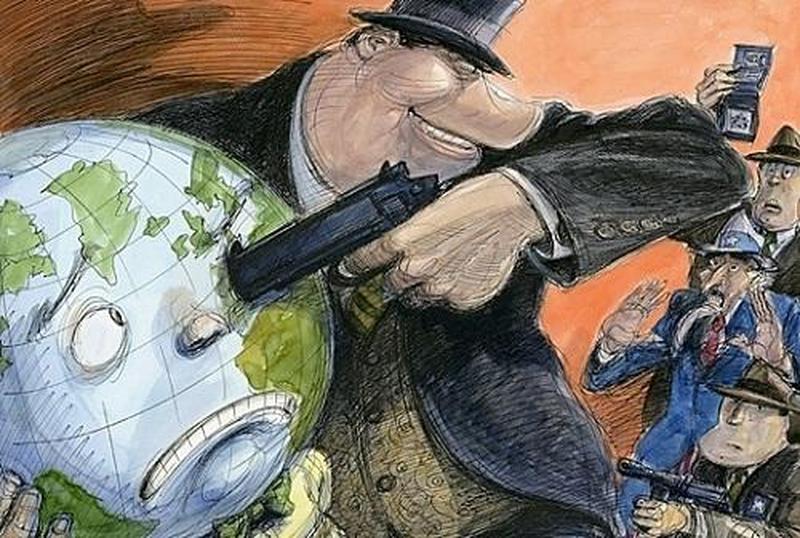MAN this sounds like the world war 1 videos i posted, What a bunch of corrupt ****s they are
DE READ the comments from the original site. I think you will like them.........
http://www.alt-market.com/articles/3627-the-crash-of-the-everything-bubble-started-in-2018-heres-what-comes-next-in-2019
Authored by Brandon Smith via Alt-Market.com,
In 2018, a very significant economic change occurred which sealed the fate of the U.S. economy as well as numerous other economies around the globe. This change was the reversal of central bank policy. The era of stimulus and artificial support of various markets, including stocks, is beginning to fade away as the Federal Reserve pursues policy tightening, including higher interest rates and larger cuts to its balance sheet.
I warned of this change under new Chairman Jerome Powell at the beginning of 2018 in my article âNew Fed Chairman Will Trigger Stock Market Crash In 2018â. The crash had a false start in February/March, as stocks were saved by massive corporate buybacks through the 2nd and 3rd quarters. However, as interest rates edged higher and Trumpâs tax cut cash ran thin, corporate stock buybacks began to dwindle in the final quarter of the year.
As I predicted in September in my article âThe Everything Bubble: When Will It Finally Crash?â, the crash accelerated in December, as the Fed raised interest rates to their neutral rate of inflation and increased balance sheet cuts to $50 billion per month. In 2019, this crash will continue as the fed resumes cuts once again in mid-January.
It is important to note that when we speak of a crash in alternative economic circles, we are not only talking about stock markets. Mainstream economists often claim that stocks are a predictive indicator for the future health of the wider economy. This is incorrect. Stocks are actually a trailing indicator; they tend to crash well after all other fundamentals have started to decline.
Housing markets have been plunging in terms of sales as well as value. The Fedâs interest rate hikes are translating to much higher mortgage rates in the wake of overly inflated prices and weaker consumer wages. Corporate buyers in real estate, which have been propping up the housing market for years, are now unable to continue life support. Corporate debt across the board is at all-time highs not seen since the crash of 2008, and with higher interest rates, borrowing cheap capital is no longer an option.
In November 2018, home sales posted the steepest decline in over 7 years.
Auto markets, another major indicator of economic stability, have been plunging in extreme fashion. Autos saw steep declines throughout the last half of 2018, once again as higher Fed interest rates killed easy credit ARM-style car loans.
U.S. credit is also drying up as investors pull capital from volatile markets and interest rates rise. Liquidity is disappearing, which means debt is becoming more expensive, or inaccessible to most people and businesses.
A false narrative is being presented in the mainstream on these circumstances â by both the media and central bankers. There has been a considerable amount of âjawboningâ by economic authorities and mainstream analysts in an attempt to keep the public distracted from the economic crisis as well as keep the investment world engaged in trading with blinders on. With the propaganda going into overdrive, we must cut through the fog and mirrors, gauging the most important threats within the system and determining when they might escalate.
Make no mistake, as erratic and unstable as 2018 was, 2019 will be far worse.
The Federal Reserve Will Continue Tightening
There is a lie circulating in the media that Jerome Powell and the Fed are âheroicâ for âgoing againstâ past central bank regimes and removing easy money policies. This is the exact opposite motive behind what is happening. We have to remember that it was the Fed and other central banks that created the initial crash in 2008 through easy money policies. They then deliberately created an even bigger bubble (the âeverything bubbleâ) through more monetary stimulus; a bubble so large that it would collapse the entire U.S. economy including bond markets and the dollar if it ever burst.
This circular process of crisis-stimulus-crisis is one that that the central bank has used for over a century. Former Fed officials like Ben Bernanke and Alan Greenspan have openly admitted to central bank culpability for the Great Depression as well as the crash of 2008. Though, as they do this they also assert that they were ânot aware at the timeâ of the greater danger. I donât buy that for a second.
In almost every instance during which the Fed created a crash environment, banking institutions were able to use the opportunity to snatch up hard assets for pennies on the dollar, as well as steal more political and social power. During the Great Depression, major banks absorbed thousands of smaller local banks as well as all the assets those banks held. In 2008, banks and corporations enjoyed a deluge of easy money paid for by American taxpayers for generations to come, while also vacuuming up hard assets like distressed home mortgages.
An even greater prize for banking elites is global centralization of economic authority, which is what I believe their goal is as the next engineered crash runs its course. As crisis leads to catastrophe, it will be institutions driven by globalism like the International Monetary Fund (IMF) and Bank for International Settlements (BIS) that step in to âsave the dayâ.
As I have noted time and time again, Jerome Powell is well aware of what will happen as the Fed tightens. He is recorded in the Fed minutes of October 2012 discussing the consequences, including his hint of an impending crash if the Fed shut down stimulus measures, raised interest rates and cut the balance sheet.
Yet, Powell continues tightening all the same, indicating that Fed actions and the results are quite deliberate. Recent statements by Powell have been wrongly interpreted by the mainstream to indicate that the Fed might back off of tightening policies. I predict that this will not happen, at least not until the crash has already run its course.
I expect Powell to continue balance sheet cuts at around $50 billion per month through until perhaps the end of 2019. I also hold to my original prediction last year that the Fed will hike interest rates in 2019, at least two more times, with a hike in March. The Fed has continued to show a propensity for double talk on "accommodation", and there is a good reason for this...
Stock Markets Will Continue to Plunge
Many alternative economists have been pointing out over the years the direct correlation between the Fed balance sheet and stock market prices. As the Fed bought up assets, the stock market rose exactly in tandem. As the Fed dumps assets, stocks fall with increasing speed and volatility.
If you want a perfect example of this, simply examine the central bank's FRED balance sheet totals and compare them with a year long graph of the S&P500. Do not only look at the stock plunges, but also the stock rallies. Dramatic cuts in December facilitated the start of the crash; the recent bounce occurred in part due to end of the year investment by corporate pension funds, searching desperately for yield in an environment where bonds are no longer viable or safe. However, take note that the first week of January also saw Fed cuts flatline.
What does this mean? Without a massive alternative capital source like stock buybacks in play, every new large Fed asset cut will result in a steep decline around the middle of each month. Every pause in cuts will result in a bounce, but to lower highs. The ceiling for rallies and the expectations of investors will gradually dwindle until the reality that the party is over finally hits them.
The Fedâs recent "dovish" comments, in my view, are completely fraudulent and highly calculated. Because the central bank has cut stimulus and raised interest rates to the point that corporations can no longer afford massive buyback binges, there is nothing left to support stocks except disinformation, blind faith, and a 1-2 week pause in balance sheet cuts.
This is a controlled demolition of the economy and markets. The Fed will jawbone as much as possible to keep the system from imploding too fast, because jawboning is the only tool that is left. In the meantime, Powell will keep cutting assets and raising interest rates on schedule. This will inevitably translate into lower prices in equities as the system is âsteam valvedâ down. Blind faith by investors will only go so far. They will be left holding the bag, right along with pensions.
I expect stocks will resume their steep decline through 2019, and will fall well below support levels seen in 2017. If Decemberâs decline was any indication, as long as the Fed continues its current path of balance sheet cuts, I see the Dow in the 17,000 to 18,000 point range in March-April.
Trump Will Get The Blame For The Crash

LOT more,,,,,,,,,,,,,,,,,,,,,,,,

Realist - Everybody in America is soft, and hates conflict. The cure for this, both in politics and social life, is the same -- hardihood. Give them raw truth.
